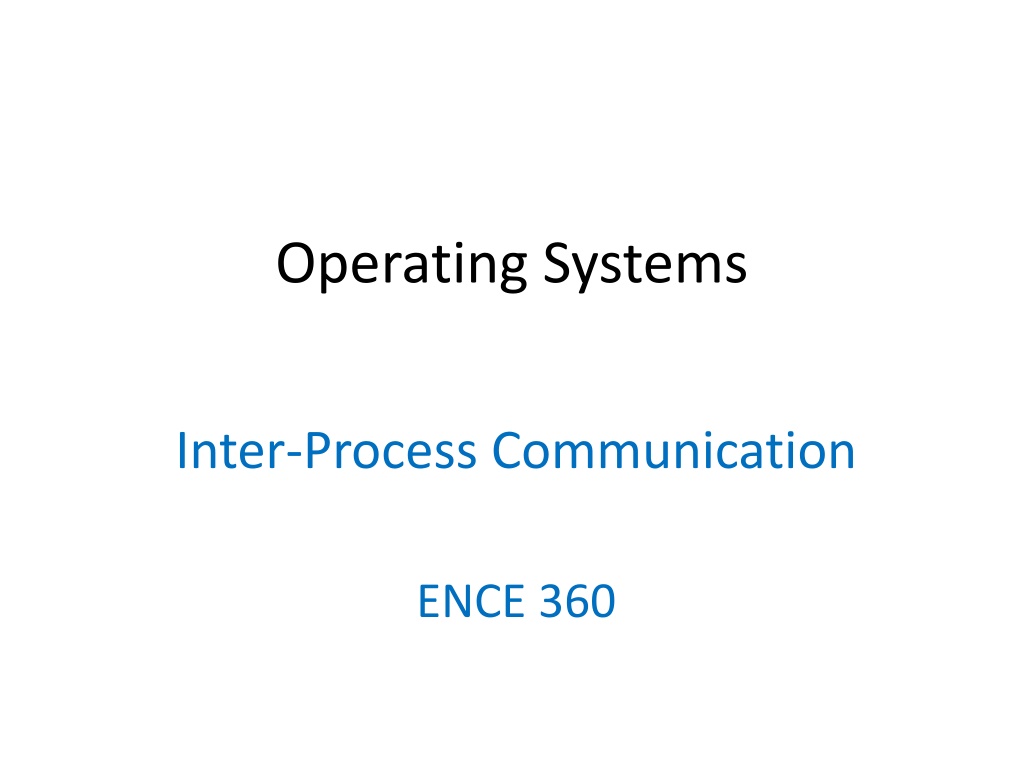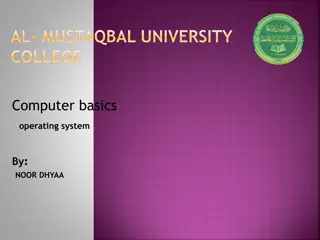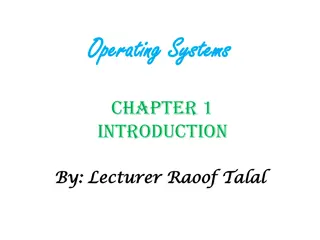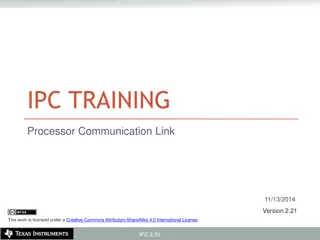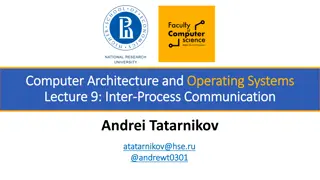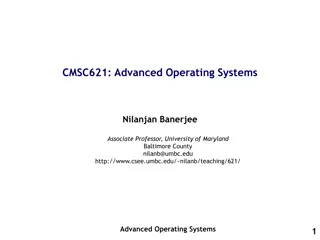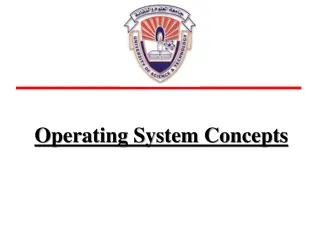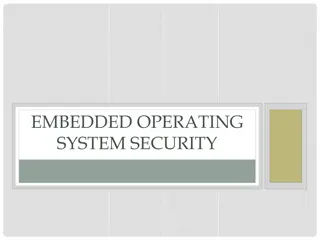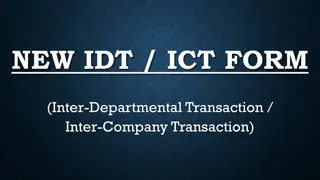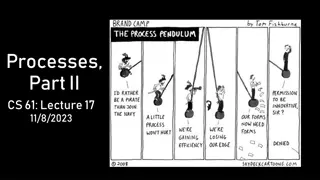Understanding Inter-Process Communication in Operating Systems
Exploring the concept of Inter-Process Communication (IPC) in operating systems, this content delves into how processes cooperate, different IPC paradigms like message passing and shared memory, examples of cooperating processes, and the challenges and advantages of process cooperation. It also addresses the crux of enabling efficient process communication and coordination, discussing mechanisms of data sharing, communication, and problem avoidance in IPC.
Download Presentation

Please find below an Image/Link to download the presentation.
The content on the website is provided AS IS for your information and personal use only. It may not be sold, licensed, or shared on other websites without obtaining consent from the author. Download presentation by click this link. If you encounter any issues during the download, it is possible that the publisher has removed the file from their server.
E N D
Presentation Transcript
Operating Systems Inter-Process Communication ENCE 360
Outline Introduction Examples Shared Memory Files Pipes Signals Pages 43-45, 733-734 MODERN OPERATING SYSTEMS (MOS) By Andrew Tanenbaum
Interprocess Communication (IPC) Independent process cannot affect or be affected by execution of another process Cooperating process can affect or be affected by execution of another process Advantages of process cooperation: Information sharing Computation speed-up Modularity Convenience Examples?
Cooperating Processes - Examples Communication example Unix shell cat file.jpg | jpegtopnm | pnmscale 0.1 | ssh claypool@host.com cat > file.pnm Sharing example print spooler Processes (A, B) enter file name in spooler queue Printer daemon checks queue and prints A B 9 free print daemon ... ... letter hw1 (empty) 6 7 8
Interprocess Communication (IPC) Independent process cannot affect or be affected by execution of another process Cooperating process can affect or be affected by execution of another process Advantages of process cooperation: Information sharing Computation speed-up Modularity Convenience THE CRUX OF THE PROBLEM: HOW TO EFFICIENTLY ENABLE PROCCESS COMMUNICATION/COORDINATION? How do processes share data? How do processes communicate data? How to avoid problems/issues when sharing data?
IPC Paradigms a) Message passing Why good? All sharing is explicit less chance for error Why bad? Overhead. Data copying, cross protection domains Shared Memory Why good? Performance. Set up shared memory once, then access w/o crossing protection domains Why bad? Can change without process knowing, error prone b)
Outline Introduction Examples Shared Memory Files Pipes Signals (next) (done)
Some IPC Mechanisms Shared memory Through shared variables File system By reading and writing to file(s) Message passing By passing data through pipe Also: remote procedure call, sockets Signal By indicating event occurred B A ? C
IPC Using Shared Memory System call to create shared memory segment Once created, access as normal memory
Shared Memory - Example See: shmem.c
Outline Introduction Examples Shared Memory Files Pipes Signals (done) (next) (done)
IPC Using Files Process writes to file, another reads from same file Note, if both writing, requires locking to share file safely File locks the whole file (e.g., flock(), fcntl()) Record locks portion of file (e.g., databases) A B file system Note! Windows and Linux do not lock by default
File - Example See: file.c
Outline Introduction Examples Shared Memory Files Pipes Signals (done) (done) (next) (done)
IPC Using Pipes \0 b l a h . c read fd write fd A bounded buffer, provided by OS Shared buffer Block writes to full pipe Block reads to empty pipe System calls to create/destroy e.g., pipe() System calls to read/write e.g., read(), write()
Pipe - Example See: pipe.c
Named versus Unnamed Pipes Unnamed pipe int pid[2]; pipe(pid); write(pid[1], buffer, strlen(buffer)+1); read(pid[0], buffer, BUFSIZE); Persistent (after processes exit) Can be shared by any process) Named pipe int pid0, pid1; mknod("named_pipe_filename", S_IFIFO | 0666, 0); pid1 = open("named_pipe_filename", O_WRONLY); pid0 = open("named_pipe_filename", O_RDONLY); write(pid1, buffer, strlen(buffer)+1); read(pid0, buffer, BUFSIZE); Can be treated like FIFO file
The Shell Using a Pipe One process writes, 2nd process reads % ls | more 1 Shell 2 3 ls more stdout stdin Shell: 1 Create unnamed pipe 2 Create process for ls, setting stdout to write side 3 Create process for more, setting stdin to read side Ok, but how to set stdout and stdin?
File Descriptors int fd = open( blah , flags); 0-2 standard for each process Used for files, pipes, sockets Can be changed Openend Closed Copied (dup2()) read(fd, ); User Space System Space stdin stdout stderr 0 1 2 3 ... (index) (Per process)
Example dup2 See: dup.c
0 stdin Example dup2 w/pipe before File Descriptor Table (FDT) after fork parent 1 stdout 1 2 stderror 0 2 3 pipe read parent 4 pipe write 3 4 pipe 0 stdin FDT after fork child 4 3 1 stdout child 2 stderror 3 pipe read 1 2 0 4 pipe write after 0 pipe read FDT after dup2 parent 1 1 stdout 2 2 stderror parent 3 pipe read 0 4 pipe write pipe 1 0 stdin FDT after dup2 child child 1 pipe write 2 2 stderror 0 3 pipe read 4 pipe write 0 stdin 0 pipe read 1 pipe write FDTs after execl 1 stdout 2 stderror 2 stderror
Outline Introduction Examples Shared Memory Files Pipes Signals (done) (done) (done) (next) (done)
IPC using Signals Signal corresponds to an event Raised (or sent ) by one process (or hardware) Handled by another E.g., ctrl-c sends signal (SIGINT) to process Originate from various sources Hardware. e.g., divide by zero Operating System. e.g., file size limit exceeded User (shell) Keyboard. e.g., ctrl-Z (SIGTSTP), ctrl-C (SIGINT) Kill command Other processes. e.g., child Handling varies by processes default most terminate process catch catch and do appropriate action ignore do not take any action, but do not terminate B child process exiting C stop kernel illegal instruction timer expired D A
Generating & Handling Signals Generate kill()- send signal to specified process kill(int pid, int sig); signal: 0-31 pid == 0 goes to all user s processes alarm()- send SIGALRM to itself after specified time raise()- send signal to itself kill(getpid(), sig); Handle sigaction() - change behaviour for when signal arrives See: man 7 signal
Example - Signal See: signal.c Note, handling is like interrupt 1. Store state/location where process was (stack) 2. Move to handler 3. When handler done, return to previous location
Example Signal-2 See: signal-2.c
Defined Signals SIGABRT Process abort signal. SIGALRM Alarm clock. SIGFPE Erroneous arithmetic operation. SIGHUP Hangup. SIGILL Illegal instruction. SIGINT Terminal interrupt signal. SIGKILL Kill (cannot be caught or ignored). SIGPIPE Write on pipe no one to read it. SIGQUIT Terminal quit signal. SIGSEGV Invalid memory reference. SIGTERM Termination signal. SIGUSR1 User-defined signal 1. SIGUSR2 User-defined signal 2. SIGCHLD Child process terminated SIGCONT Continue executing, if stopped. SIGSTOP Stop (cannot be ignored). SIGTSTP Terminal stop signal. SIGTTIN Background attempt read. SIGTTOU Background attempting write. SIGBUS Bus error. SIGPOLL Pollable event. SIGPROF Profiling timer expired. SIGSYS Bad system call. SIGTRAP Trace/breakpoint trap. SIGURG High bandwidth data at socket. SIGVTALRM Virtual timer expired. SIGXCPU CPU time limit exceeded. SIGXFSZ File size limit exceeded. See man pages for details
Outline Introduction Examples Shared Memory Files Pipes Signals (done) (done) (done) (done) (done) (done)
